Physical Address
304 North Cardinal St.
Dorchester Center, MA 02124
Physical Address
304 North Cardinal St.
Dorchester Center, MA 02124
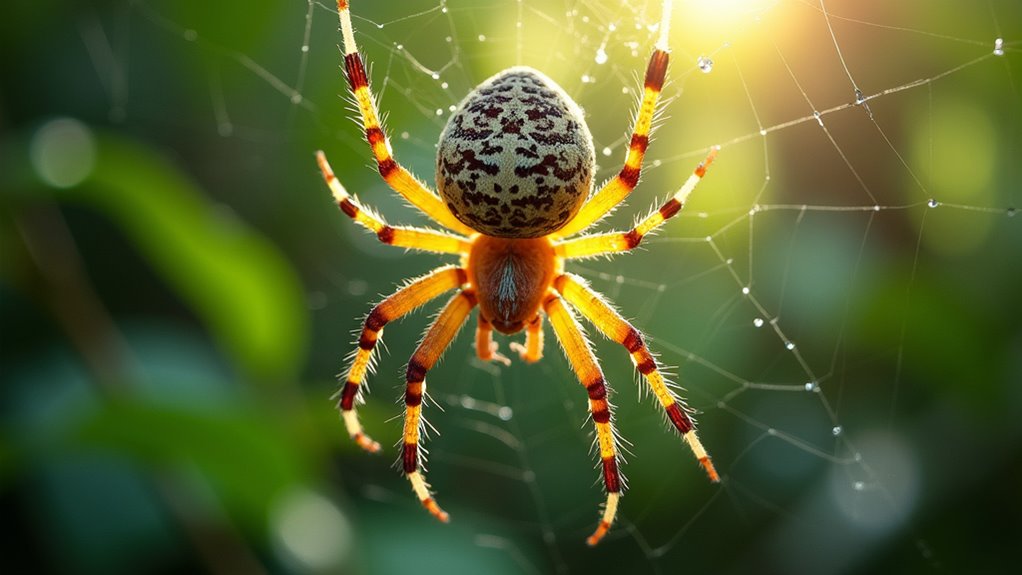
Jump into Thailand's arachnid world, where massive tarantulas and tiny jewel spiders lurk in unexpected places - but which ones should you fear?
Thailand’s spider population includes the distinctive Thai Zebra Tarantula, massive Giant Huntsman (up to 30cm wingspan), colorful Jewel Spider, venomous Black Widow, solitary Black Tarantula, helpful Pantropical Huntsman, tiny Banded Phintella, and common Grey House Spider. You’ll find these arachnids across diverse habitats from rainforests to urban homes. While most are harmless and contribute to pest control, knowing which species require caution will enhance your Thai wildlife experience.
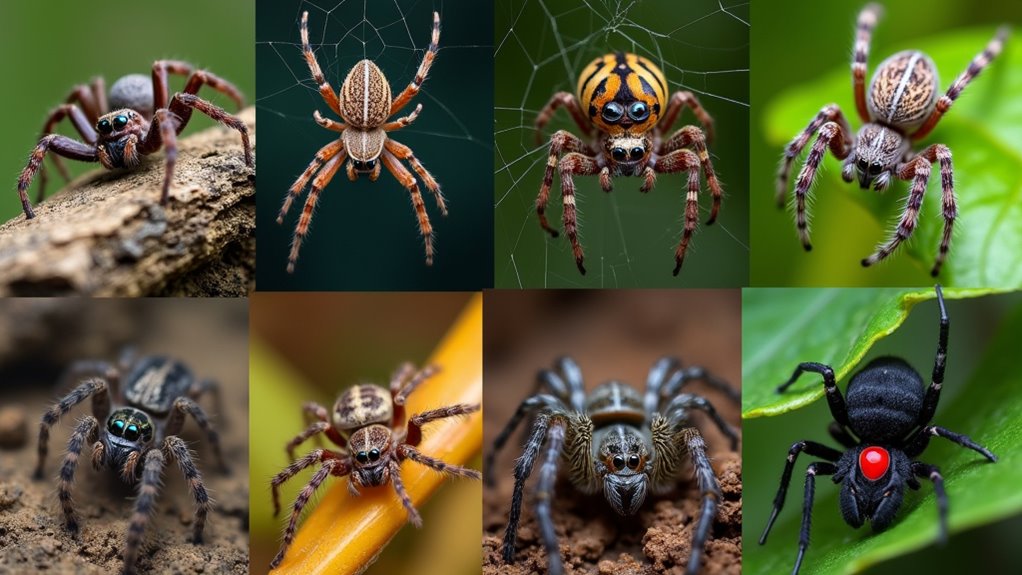
Thailand’s diverse ecosystems host numerous spider species that have adapted to various habitats across the country. Whether you’re exploring urban areas, tropical rainforests, or rural environments, you’ll encounter these fascinating arachnids.
The Black Widow, recognizable by its black body with a red hourglass mark, can be found in various habitats. In homes, you’ll often spot the Grey House Spider, which is small and harmless. Tropical forests house the Black Tarantula, which makes its home in underground burrows.
The Giant Huntsman Spider impresses with its massive leg span of up to 30 cm, while the colorful Jewel Spider distinguishes itself with its spiky abdomen. You might also encounter the tiny Banded Phintella during daytime, the Harvestman (not technically a spider), and various garden species. Golden Orb Web Spiders create intricate golden webs that shimmer beautifully in sunlight, making them easily identifiable in Thailand’s forests. Many of these spider species can be observed in the natural settings of beach destinations throughout Thailand’s coastal regions.
Among Thailand’s most mesmerizing arachnids, the Thai Zebra Tarantula emerges as a remarkable rainforest inhabitant. Scientifically known as Cyriopagopus albostriatus, this species makes its home in the tropical forests of Thailand, Myanmar, and Cambodia, preferring mountain slopes where it creates silk-lined burrows. For visitors exploring Thailand’s natural wonders, knowing about these creatures can enhance your safety in Thailand while appreciating the country’s biodiversity.
You’ll recognize this tarantula by its distinctive white stripes on dark legs, earning its zebra nickname. Its scientific name directly reflects these markings, with “albo striatus” translating from Latin to mean white stripes. Unlike web-spinning spiders, it’s an ambush predator that relies on its burrow for hunting and shelter.
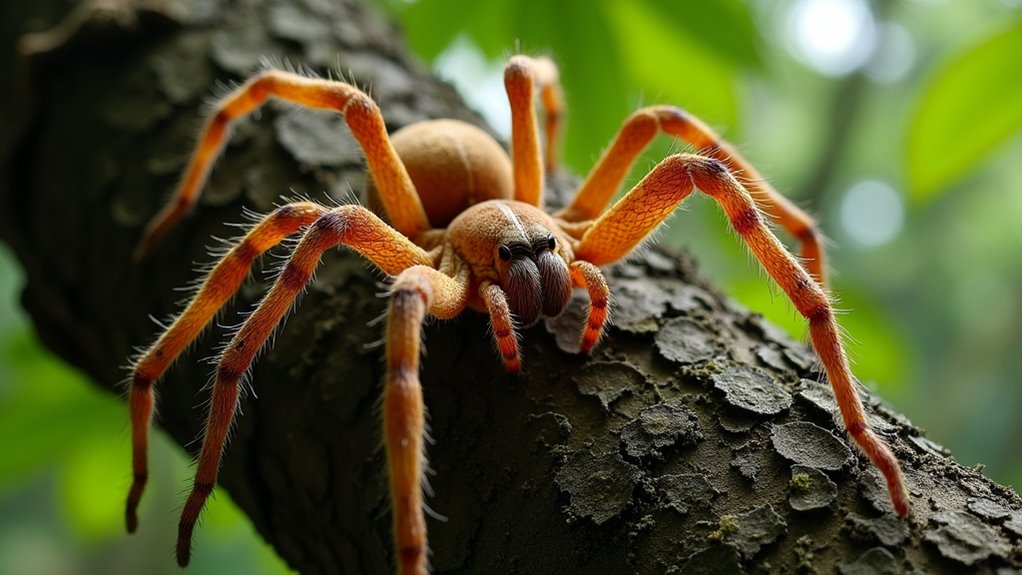
When you encounter the Giant Huntsman Spider in Thailand’s limestone caves, you’re witnessing one of the world’s most impressive arachnids. With leg spans reaching up to 30 cm (12 inches), these golden-brown giants dwarf most other spider species.
Despite their intimidating size, these nocturnal hunters prefer fleeing to confrontation. They don’t build webs; instead, they use their remarkable speed to ambush prey, from insects to small vertebrates.
Though enormous, these nocturnal predators would rather escape than attack, using their astonishing speed to ambush prey rather than webs.
Their flattened bodies allow them to squeeze into tight rock crevices during daylight hours.
While the record-breaking specimens are primarily documented in neighboring Laos, similar enormous Huntsman varieties exist in Thailand’s cave systems. Unlike the bustling beach destinations of Phuket and Koh Phangan, these caves remain relatively undisturbed, providing ideal habitats for these remarkable creatures. They’ve become prized in the terrarium trade, where captive specimens reportedly reach 25-30 cm across. Forest monks and mushroom hunters in Northeast Thailand have known of these giant Huntsman spiders for generations.
Don’t worry—their venom isn’t medically significant to humans.
While the Giant Huntsman may impress with its size, the Jewel Spider enthralls with its striking beauty. These colorful arachnids stand out in Thailand’s gardens with their distinctive spiny projections and hardened exoskeletons. Unlike most solitary orb-weavers, they often form colonies with overlapping webs.
You’ll find these non-aggressive spiders throughout Thailand’s forests and gardens, where they help control pest populations. Their shiny black bodies with variable bright markings give them their jewel-like appearance. Their vibrant appearance makes them popular subjects for macro photography. Even in coastal areas such as Thailand’s beaches, these adaptable creatures can establish their intricate webs among vegetation.
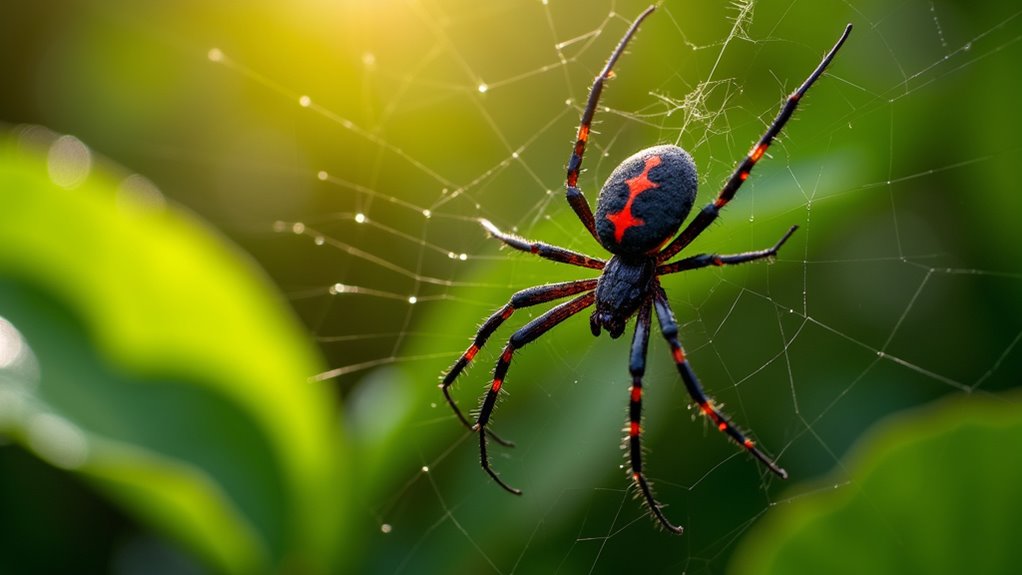
The Black Widow spider deserves its notorious reputation as one of Thailand’s most recognizable venomous arachnids. You’ll identify females by their shiny black bodies and distinctive red hourglass marking on the abdomen, while males are smaller with less prominent markings.
Found nationwide in both urban and rural settings, these spiders prefer sheltered, low-lying areas like woodpiles and under outdoor furniture. Their powerful webs are constructed from irregular, sticky silk that effectively traps prey. They’re most active after dusk, spinning asymmetrical webs close to the ground.
Black Widows lurk in Thailand’s shadows, weaving their irregular webs near the ground—always waiting for nightfall’s hunting opportunities.
Their bite contains potent neurotoxin that can cause severe symptoms including muscle rigidity, vomiting, and abdominal cramps. While rarely fatal, seek immediate medical attention if bitten.
Protect yourself by wearing gloves when gardening, avoiding blind reaches into dark spaces, and inspecting outdoor furniture before use. Unlike the Maldives, Thailand’s tropical climate creates ideal conditions for various spider species to thrive year-round.
Nestled within the lush rainforests of Khao Sok National Park, Thailand’s black tarantula (Cyriopagopus minax) creates its hidden kingdom underground.
You’ll find these impressive arachnids burrowing in soil or behind old tree bark, where they construct silk-lined homes in both lowland and highland forests.
These solitary creatures emerge at night to hunt, capturing insects and small arthropods with their substantial leg span and robust bodies. Their predatory behavior contributes significantly to ecosystem health through controlling insect populations.
While exploring Khao Sok’s diverse terrain, you’ll discover this species thrives in tropical environments similar to those found on islands like Koh Lanta and Koh Samui.
If you’re hiking through Khao Sok, remember:
While popular in the pet trade, their natural habitat in Thailand’s tropical forests is their true home.
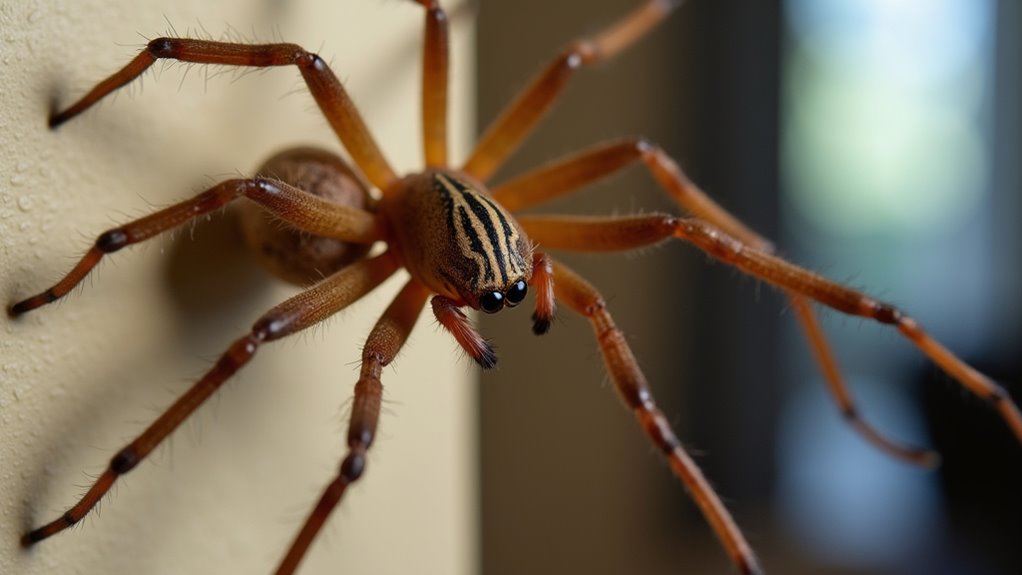
Moving from deep forest burrows to human dwellings, you’re likely to encounter Thailand’s Pantropical Huntsman Spider (Heteropoda venatoria) in your home or garden. These impressive arachnids feature a body length of 2.2-2.8 cm with leg spans reaching 7-12 cm, appearing in brown or flat gray colors.
Don’t be alarmed by their size—these nocturnal hunters are valuable allies. They’ll control cockroach populations without building webs, using their speed and strong jaws to capture prey. Males produce rhythmic ticking sounds by vibrating their abdomen during courtship to attract females.
While they possess venom that can cause swelling and pain, they rarely bite humans unless provoked.
In tropical regions, many homeowners appreciate these spiders as free pest management. Visitors exploring Thai islands often spot these helpful creatures in beach bungalows and resort accommodations. Despite cultural fears about their intimidating appearance, huntsman spiders contribute considerably to maintaining ecological balance in both urban and rural Thai environments.
From towering huntsman spiders, we shift our attention to one of Thailand’s most charming arachnids—the Banded Phintella (Phintella vittata). These tiny jumpers measure just 6-7mm long but pack impressive hunting skills and personality into their diminutive frames.
You’ll spot them by their distinctive black and white banded abdomen and mainly black legs.
If you’re exploring Bangkok or forest floors throughout Thailand, look for these daytime hunters in:
These picky eaters are solitary but engaging to observe in action. They display vibrant iridescent colors that make them stand out among other spiders typically found in bushes.
Many travelers visiting Koh Phi Phi might encounter these fascinating jumping spiders while exploring the lush vegetation of southern Thailand.
You’ll find Thailand’s spider diversity fascinating beyond these eight common species. With over 600 documented spider species in the country, you’ve only glimpsed a fraction of Thailand’s arachnid population. Whether you’re an enthusiast or cautious observer, understanding these eight-legged neighbors helps you appreciate their ecological roles and navigate encounters with greater confidence and less fear.